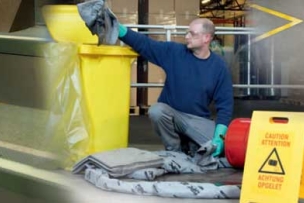With so many Americans working harder to make ends meet with a second job, safety concerns shouldn’t hold them—and the companies they work for—back.
Though most working Americans spend their time at one job, that doesn’t hold true for everyone.
Today, 5.1 percent of the U.S. working population—nearly 8 million people—hold more than one job at the same time, according to the Bureau of Labor Statistics. People moonlight for all kinds of reasons, and statistics show most are looking to beef up their income beyond a full-time paycheck. Others combine part-time jobs to create a regular income, while a smaller number work two full-time jobs.
The ranks of job jugglers are likely to expand as increasing numbers of employers in the emerging “gig” economy rely on contracting with independent workers for freelance or short-term stints across a variety of fields, even heavy industry. By 2020, more than 40 percent of the U.S. workforce will be independent contractors or temporary workers, estimates a study by software company Intuit.
Two Jobs, More Safety Risk
This trend poses new challenges for both workers and employers, particularly in managing potential safety risks, according to recent studies from the Liberty Mutual Research Institute for Safety. Researchers found that workers who juggle more than one job have a 27 percent higher rate of work-related injuries than single-job holders, and 34 percent higher rates of nonwork-related injuries.
This higher risk has been attributed to a range of factors, including part-time workers receiving inadequate job training or being less experienced than full-time workers. Those holding multiple jobs also work longer hours (with 1 in 4 averaging more than 60 hours per week, compared with 6 percent of single-job holders), spend more time commuting, get less sleep and have less leisure time than single-job holders, all of which may increase the risk of injury, research reveals.
More Research Is Needed
To enhance safety for this group, the Liberty Mutual research stressed the need for further study of employment situations and circumstances around injuries. Research about people who hold multiple jobs is just gaining attention, and such data are seldom captured in national surveys or by employers in their hiring decisions and injury incidence reporting systems. But other studies have demonstrated an increased risk of work-related injury associated with fatigue, long hours and shift work, particularly the so-called graveyard shift.
Training and Education May Help
Strategies to address challenges to workplace injury are applicable to risks faced by multiple-job holders, says Claire C. Caruso, Ph.D., R.N., a research health scientist at the National Institute for Occupational Safety and Health (NIOSH). “People may be cutting into their sleep to take a second job,” says Caruso, who says there’s a lack of knowledge about the importance of sleep and the dangers of running on empty.
For example, multiple studies have found that performance in a person who has been awake for 17 hours or more resembles that of someone with alcohol intoxication. Caruso advocates that both workers and employers share in the responsibility of reducing risks connected to poor sleep. “Educating workers and managers about the need for sleep, the risks attached to long work hours and working nights to help people make better decisions would be a major step to promote progress.” She also points to other NIOSH-developed best practices for employers to reduce fatigue-related workplace risk, such as rest breaks every one to two hours between shifts, evening or nights shifts of no more than eight hours, and other recommondations.
Creating a Culture of Safety
Another priority is for management to view adequate job and safety training of all workers, both full-time and part-time, as a critical driver of a company’s success, says Chip Dawson, an occupational health and safety consultant. “Safety is a leading indicator, just like sales, production and other measures, and can’t be separated from the overall culture of an organization,” Dawson says.
“Safety is a leading indicator, just like sales, production and other measures, and can’t be separated from the overall culture of an organization.”
The additional risks identified with multiple-job holders should play a role in a company’s ongoing investments in worker training, safety performance monitoring, and communications among supervisors and workers, Dawson says. “As more contingent workers come into the workplace, which seems to be a trend, it will be a huge problem for management if they’re not made part of the overall culture, trained like regular employees and not regarded as people who just fill a gap.”
Are people holding multiple jobs more at risk in the workplace?




Talk to Us!
Leave a reply
Your email address will not be published. Required fields are marked *